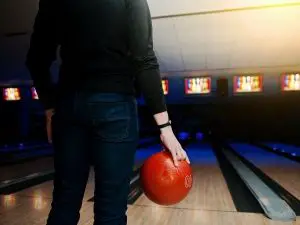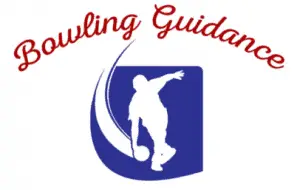 What is the oil pattern you can find in every bowling center? It is the Typical House Shot (THS) oil pattern. Now, why is it considered the most standard of them all? Well, back in the days, lanes were actually made of woods which required more oil (as wood can absorb oil) and higher maintenance. Although that got replaced by synthetic lanes, oiling of the lane is still needed. With today’s modern oiling machine, it is easy to achieve accuracy for the House Shot oil pattern. The oil is spread thinly and precisely on the lane for better scoring opportunities. So how do you slay on the THS pattern? Let’s jump right into it.
What is the oil pattern you can find in every bowling center? It is the Typical House Shot (THS) oil pattern. Now, why is it considered the most standard of them all? Well, back in the days, lanes were actually made of woods which required more oil (as wood can absorb oil) and higher maintenance. Although that got replaced by synthetic lanes, oiling of the lane is still needed. With today’s modern oiling machine, it is easy to achieve accuracy for the House Shot oil pattern. The oil is spread thinly and precisely on the lane for better scoring opportunities. So how do you slay on the THS pattern? Let’s jump right into it.
What is a house shot oil pattern?
The House Pattern is the most standard bowling oil pattern out there. You will find this pattern in any bowling alley. The specifications may vary from place to place. This 32 feet long pattern is designed to help players score higher than other oil pattern lanes. That is one of the many reasons why THS lanes are considered ‘open’ for every bowler. Whether you’re a newbie bowling for the first time or someone who is in a more competitive league or has played tournaments before, the house shot oil pattern is just perfect! But it can get a bit more challenging in a competition.
When you’re standing in front of a house shot pattern, you will see that the lane is shinier in the middle than it is on the outside close to the channel. This is because the house shot oil pattern has a higher volume of oil concentrated in the middle part of the lane. This oiled area is in between the second arrow from both of the gutters, and it runs from the foul line of the lane to approximately 2/3 of the way (so more than half) down the lane.
Now, what do you think is the ratio of the oil on a house shot pattern? Well, typically it is more than 3:1 (sometimes less than 3:1). This indicates that the oil in the center is 3 times more than it is on the outside. However, you may come across house shot patterns where the ratio is 6:1, but that is used mostly for competitions or league games.
How long is the typical house shot oil pattern?
The general rule for a house shot oil pattern is that it has to be 32 feet in length, and the oiling machine will buff it up to 40 feet. That is just enough oil to help you have the perfect shot with your ball hooking at the perfect angle that will lead to strikes.
How do you play the House oil pattern?
Unlike PBA or sports oil patterns, you don’t have to play from front to back, the usual side-to-side playing is just fine. As mentioned, house shot patterns have dry outsides. So the first duty is to find out how much of the lane is oiled and how far the dry outside area is extended.
Once you acknowledge the information, you should roll your bowling ball into the dry outsides. This will make the friction happen between your ball and the surface of the lane, which will provide you an excellent hook into the pocket, and if your shot is on point it will surely result in a strike. Straight shooters can use the inner heavier oil, meaning the center of the lane to roll the ball on a straight line and keep it inside the entire time.
Bowlers may face these two issues on a THS oil pattern- one is the distance and the other one is the amount of oil as it can either increase or decrease irregularly. So it’s wise to make the correct adjustment. There are three basic adjustments that need to be made- 1. angle changes, 2. speed changes, and 3. ball changes.
Let’s say you start playing from the 1st arrow of the lane. Now, what do you think will happen? As the THS pattern is dry on the outside, your ball will start from the dry part of the lane and that won’t make your ball hook. Rather, it will go straight into the gutter.
This happens because of the general principle which is- the dry outsides create friction and hook whereas the oily insides create skid and hold. So make sure you warm up on this oil pattern before you go for the actual game. If you miss the pocket to the right, you have to move the ball to the right. Similarly, if you miss the pocket to the left, you have to move the ball to the left. This is how you adjust the angles.
So what’s the best way to attack this oil pattern you ask? Well, let me tell you, a lot of it depends on what type of bowler you are. If you’re a straighter player, you wanna play a little more towards the outside part of the lane and use the dry part of the lane for friction to get your ball curve into the pocket. If you throw more of a hook with a stronger ball, you wanna play more towards the middle part of the lane starting from the second arrow and utilize the heavy concentration of oil to get your ball to store energy longer and curve the ball on the dry part and get it into the pockets for potential strikes. As a straight bowler, you will be needing a much aggressive bowling ball. If you’re a tweener who likes to go a bit more down and in, then you just get right in between the second arrow. And if you’re a curve player, use a less aggressive bowling ball.
Why it is called the easiest pattern?
The PBA, PWBA, and sports oil patterns are designed for advanced players as they are more difficult to play on. The Typical House Shot oil pattern on the other hand is very versatile. Bowlers of all ages and skills can easily play on it and like the scores they get. To keep the bowling centers’ businesses running, the house shot oil pattern is made easier. When a player sees that he/she is scoring better, they will eventually come back to play again. If you’re a novice, the house oil pattern is the easiest for you. If you want to get serious about bowling, you should step up to tougher lane conditions.
Conclusion
Next time you play or compete on your local house oil pattern, remember to follow how to adapt to the lane. After a bit of practice, you can play on this lane at ease. The house shot oil pattern is very forgiving and designed to score higher. You can also find many bowling balls for house oil pattern. So don’t sweat too much and get set bowling!
